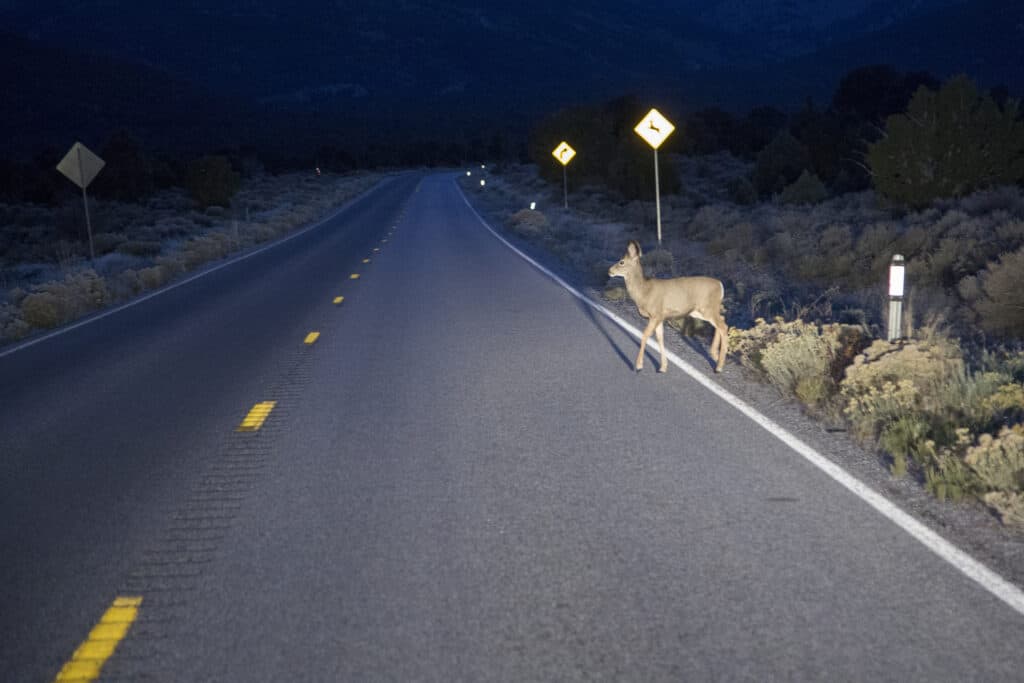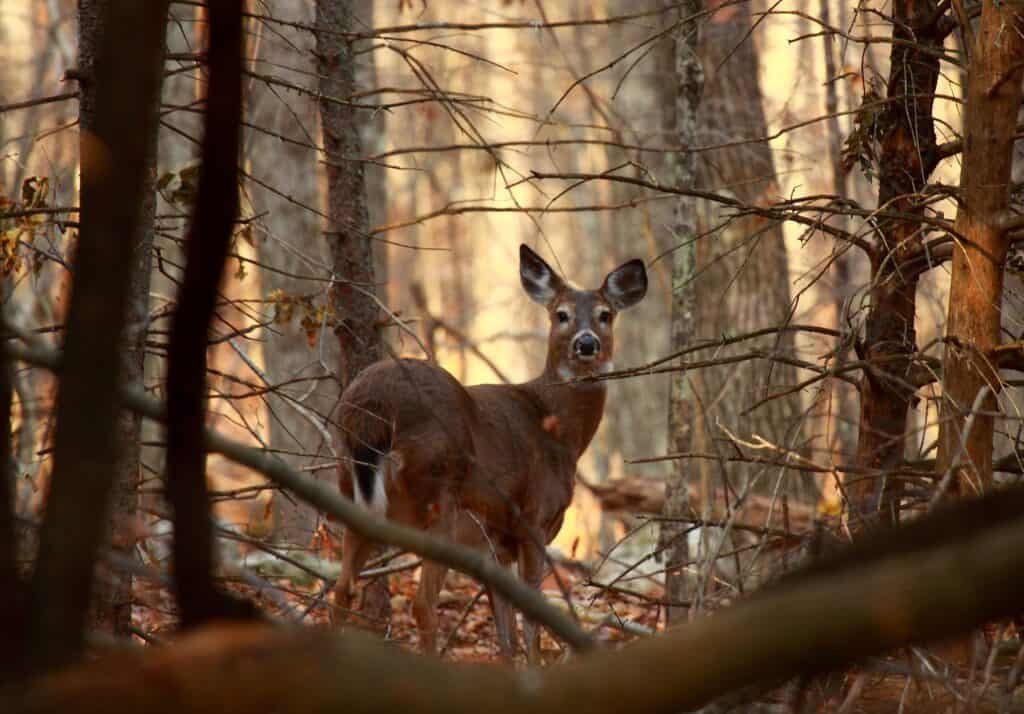Have you ever heard someone use the deer in the headlights expression? It’s a common idiomatic expression people use nowadays. But what are idiomatic expressions? And what does deer in the headlights specifically mean? Moreover, where does this expression come from, and why is deer involved in it but not another animal? Keep reading to find out the answers! We promise you’ll like the explanations!
What Does the Phrase Deer in the Headlights Mean?

is an idiom most commonly used when referring to someone who’s extremely surprised.
©iStock.com/frontpoint
Deer in the headlights is an idiomatic expression. The Merriam-Webster dictionary defines an idiom as “an expression in the usage of a language that is peculiar to itself either in having a meaning that cannot be derived from the conjoined meanings of its elements or in its grammatically atypical use of words.” In short, the words combined in the expression aren’t linked to the overall meaning of the expression. If combined, they denote a new meaning. Some of the most commonly used idioms are the following:
- Raining cats and dogs, used when it’s raining heavily
- Spill the beans, meaning to reveal a secret
- A heartbeat away (from something), which means being very close to something
- (as) healthy as a horse, used to refer to someone who’s in excellent health
Well, since we got the idiom definition clear, we can now move to explain what deer in the headlights means. This idiom is most commonly used when referring to someone who’s extremely surprised or, on the other hand, who’s in a paralyzing state of fear or bewilderment. Other idiom variations are:
- Like a deer in the headlights
- Be caught like a deer in the headlights
- Freeze like a deer in the headlights
- Be like a deer caught in the headlights
- Deer in headlights
Sometimes people also use this expression to describe someone with a stunned expression.
Where Did the Expression Deer in the Headlights Come From?
It is believed that the deer in the headlights expression appeared around the 1980s and became popular during the 1988 American presidential campaign of George H.W. Bush. Here’s why!
Senator James Danforth Quayle was considered unprepared for being Vice President. Lloyd Bentsen attacked Quayle regarding this after the latter had stated his skills were similar to those of John F. Kennedy. In reply, Bentsen said Quayle was no Jack Kennedy. The next day, commentators said Quayle had been like a deer in the headlights. Since then, the expression has become much more popular.
While it is thought to have come from this scenario, it actually dates back even further than this, to the early 1920s in Alabama, in a newspaper article that was published in the Birmingham News on May 27th, 1923. Although the phrase was originally a rabbit, rather than a deer. The article had a column called The Coal Bin by Henry Vance, where in a poem, a metaphor referring to the headlight of a train, was found in the line “have you ever seen the jack-rabbit, blinded by the headlight of the train”.
It was mentioned numerous times throughout the years, from the 1930s in screenplays taken from novels and newspaper articles throughout the 1950s.
So why do we use it to describe surprised people? Easy! It comes from the image we all know of a deer being exposed to headlights at night and freezing as it’s unsure what to do next. That’s why many deer are hit, or even killed, by vehicles. While most animals run away because they’re scared of cars, deer just stand there, and many drivers don’t have time to stop the car before hitting the animal.
Some people prefer using rabbits in the headlights rather than deer in the headlights, which has the same explanation and connotation.
Why Do Headlights Confuse Deer?

Deer vision is optimized for very low light because they are crepuscular animals.
©iStock.com/Lucila10
A deer biologist with the Kentucky Department of Fish and Wildlife Resources, David C. Yancy, stated that deer vision is optimized for very low light because they’re crepuscular animals. So when it’s dark, their eyes are fully dilated to allow them to capture as much light as possible.
If a deer happens to pass a car, its headlights will temporarily blind the animal, and it will freeze until its eyes adjust to the light.
What Are Some Other Idiomatic Expressions With Deer?
(As) Swift as a deer is another expression inspired by a deer’s behavior. People use it regarding activities that are done incredibly speedily or swiftly. Here are some examples:
- He was so rushed he got out of the house swift as a deer.
- The burglar bolted out of the room swift as a deer before the police arrived.
Other Animal Phrases
Believe it or not, many idiomatic expressions are inspired by animal activity, behavior, or appearance.
Here are some of them:
- To be a bull-head/bull-headed, used to describe someone very stubborn
- To smell fishy, used to describe a situation that denotes something suspicious
- To talk the hind legs off a donkey, used to describe people who talk too much
- Cat nap, used to describe a short sleep
- Hold your horses!, used to tell someone to be patient
- To kill two birds with one stone, used to describe situations in which one gets two things done at once
- To take the bull by the horns, used to describe situations in which someone boldly faces a challenge
- At a snail’s pace, used to describe situations or people progressing or moving very slowly
- To open a can of worms, used to indicate that someone created many new problems
- To get your ducks in a row, used with the meaning of “organizing things.”
Incredible Deer Facts

Deer are most active at dawn or dusk.
©Gary Gello/Shutterstock.com
If this idiomatic expression aroused your curiosity about deer, check out these incredible deer facts:
- Did you know that not all deer have brown-reddish coats? Some deer have a brown coat with white spots on it or a predominantly white coat with brown spots. These deer are called piebald deer. Other individuals are completely white, and they are called albino deer. Moreover, some deer are dark brown or black, and they are called melanistic deer.
- Deer are crepuscular animals, which means they’re most active at dawn or dusk because that’s when they see best.
- While most people like feeding deer, it does not benefit the deer population. Moreover, it is legally forbidden to feed deer in some parts of the world because this can attract them to urban areas and eventually damage their population.
Up Next:
- What Do Deer Eat?
- How and Where Do Deer Sleep? Patterns and Habitats
- Deer Antlers: 10 Fun Facts You Should Know
The photo featured at the top of this post is © iStock.com/Lucila10
Sources
- The Free Dictionary, Available here: https://idioms.thefreedictionary.com/Deer+in+Headlights
- Cambridge Dictionary, Available here: https://dictionary.cambridge.org/dictionary/english/be-like-a-deer-rabbit-caught-in-the-headlights
- FluentU, Available here: https://www.fluentu.com/blog/english/english-animal-idioms/
- The Word Detective, Available here: http://www.word-detective.com/2009/04/deer-in-the-headlights/
Thank you for reading! Have some feedback for us? Contact the AZ Animals editorial team.






